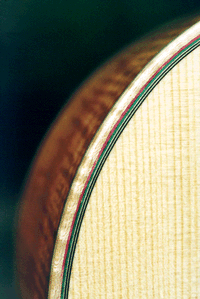
PURFLING
 The stripes you see here are not painted on, rather they are comprised of laminated, dyed holly veneers. The corner joint on this guitar incorporates a laminant made up of eleven separate strips of wood. |
Purfling is used for more than aesthetics; it helps reinforce the edge grain of the thin pieces used to construct a musical instrument; it prevents splitting and checking. Most purflings are made from thin veneers of diffused porous hardwoods such as holly, or boxwood. The veneers are dyed with aniline stains or vegetable dyes to yield a rainbow of colors, selected to compliment the ornamentation of the instrument. Often times instead of simple strips, purfling can be a mosaic design that matches or contrasts with the marquetries used in the rosette.
|
| The binding (in this case flammed maple) is used to reinforce the corner joint where the top and back of the instrument are glued together. It protects the edge grain of the delicate pieces and helps make the glue joint more rigid. Most commercial guitar manufactures employ the use of plastics for this purpose. The plastics are very hard and do a serviceable job. Custom builders use wood because a better glue joint is possible, and even though it is more difficult to bend wooden bindings so that they will conform to the complex curves of the guitar's body, the better builders continue to use wood for this purpose because it is superior mechanically, and more pleasing to the eye. |

|
copyright 1997, anthony huvard, http://www.cybozone.com site maintained by cyboboy@cybozone.com